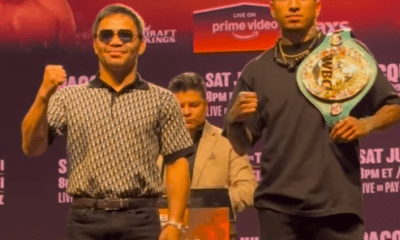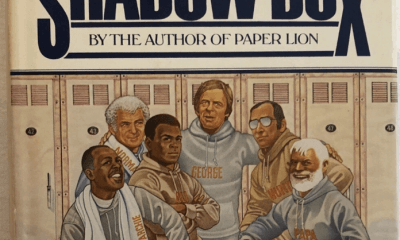Featured Articles
Geale Latest Aussie To Seek Greater Fame, Fortune In The U.S.
It shouldn’t surprise anyone that IBF middleweight champion Daniel Geale is the about to become the latest Australian celebrity to attempt to increase his American visibility – and, by extension, his worldwide fame and fortune – by coming to the United States to do his thing.
Hey, it’s a tactic that worked pretty well for actors Errol Flynn, Mel Gibson, Russell Crowe, Nicole Kidman and Paul Hogan, singers Olivia Newton John and Keith Urban, golfer Greg Norman and tennis superstars Rod Laver, John Newcombe, Ken Rosewall, Margaret Court and Evonne Goolagong Cawley.
“I feel very hungry. It’s one thing that I haven’t conquered yet, coming to the U.S. to fight,” said Geale (29-1, 15 KOs), who will be making his American debut Saturday night when he puts his title on the line for the fifth time against England’s Darren Barker (25-1, 16 KOs) at The Revel in Atlantic City, N.J. The fight will be televised live by HBO, as will the taped showing of a defense by WBO light heavyweight champion Nathan Cleverly (26-0, 12 KOs), of Wales, against Russian-born knockout artist Sergey Kovalev (21-0-1, 19 KOs) from Cardiff, Wales.
If the 32-year-old Geale can win convincingly enough, and excitingly enough, in his HBO-televised introduction to American fight fans to whom he remains mostly a rumor, he could be ticketed for high-paying return engagements on these shores. But if it doesn’t work out quite as he and his American promoter, Gary Shaw, are hoping, it wouldn’t be the first time an iconic Australian boxer went home disappointed.
Consider the cautionary tale of Jeff Fenech, a three-time world champion who arrived for his own American premiere with considerably more fanfare than is accompanying Geale’s first working trip to a place where it once was said the streets were lined with gold.
Fenech, whom many Australian boxing experts believe is the finest fighter that country has ever produced, was a 27-year-old sensation, at least in his homeland, when he was brought to Las Vegas for a June 28, 1991, bout with WBC super featherweight champ Azumah Nelson, of Ghana, at The Mirage. It was the primary undercard attraction of a show headlined by the rematch between heavyweight bombers Mike Tyson and Razor Ruddock.
Promoter Don King had signed Fenech, whose attacking, aggressive style had been likened to that of Tyson and Roberto Duran, to a four-fight, $5 million contract. The most Fenech ever had been paid for a night’s work in Australia, where all of his previous 25 bouts had been staged, was around $500,000.
“Americans don’ really know Jeff Fenech,” Fenech said a few days before his ballyhooed showdown with Nelson. “But after this fight, maybe they’ll sit up and take notice.
“I kind of feel like I’m the victim of circumstances. I’ve fought in Australia throughout my career because I wanted to. I would have been perfectly content to have had all the rest of my fights in Australia. But I also recognize that the money’s here in the States. I don’t think I would be paid as much as I am to fight Azumah Nelson in Australia. I’m not sure Australia could afford this fight in any case. I guess I always knew that until I came here, I’d never get the recognition I deserve.”
Unfortunately for Fenech, who went off as a 2-1 favorite, the great Nelson – who, like Fenech, is enshrined in the International Boxing Hall of Fame – retained his title on a draw. The Fenech Victory Tour in the U.S. never materialized; he fought only once more in America in his remaining seven bouts until his retirement in 2008, an eighth-round stoppage of Tialano Tover on Nov. 18, 1995, in Atlantic City’s Boardwalk Hall. Two of those final seven fights were rematches with Nelson, both in Australia, with each winning once to leave their series deadlocked at 1-1-1.
It has been much the same story for most if not all of the best native-born Australian boxers. Lionel Rose, Jimmy Carruthers, Les Darcy, Johnny Famechon, Anthony Mundine and Jeff Harding all held world titles at one point or another, but they fought seldom, if ever, in the U.S. and were known here only by hardcore American fans. What about Kostya Tszyu and Vic Darchinyan, you say? Tszyu was based in Australia throughout his pro career but he came from Russia, and the same can be said of Darchinyan, who was Armenian. Even the sainted Fenech, born in Sydney, had Maltese parents.
At 32, Geale is rightly considered to be one of the best 160-pounders on the planet. But he is less known here, and everywhere, than WBC champion Sergio Martinez, of Argentina, and WBA titlist Gennady Golovkin (27-0, 24 KOs), who is from Kazakhstan but lives in Germany. Martinez also has the advantage of having fought 14 times in the U.S. and Golovkin three times, a good many of Martinez’s appearances here and all of Golovkin’s getting prime-time television exposure.
Golovkin also has the advantage of being a lights-out puncher whose explosive finishing power presumably puts him in the same must-watch category as Argentina’s Lucas Matthysse (34-2, 34 KOs), emerging American heavyweight Deontay Wilder (29-0, 29 KOs) and, yes, Kovalev, whose scrap with Cleverly – which, if he wins, could lead to a subsequent matchup with ageless legend Bernard Hopkins – probably is regarded by most HBO viewers as the more compelling reason to watch Saturday’s split-site doubleheader.
Geale is a good offensive fighter and an effective counter-puncher, but his knockout ratio is not so high that it suggests he is some sort of absurdly destructive Thunder from Down Under. And Barker, who gave Martinez a problem or two before he was TKO’ed in the 11th round on Oct. 1, 2011, in Boardwalk Hall, is capable in his own right and hardly disposed to help make Geale’s initial turn in the U.S. spotlight a smashing success.
Unlike Fenech, however, Geale has one thing to his advantage as he unveils himself to hard-to-sway American spectators who do not give their hearts readily to some other country’s hero. He has fought outside of Australia twice, both in Germany, defeating Sebastian Sylvester and avenging his only loss, to 38-year-old countryman and former world champ Anthony Mundine.
“People forget that Daniel went overseas and fought two different fighters and came out on top,” Shaw pointed out. “Daniel Geale doesn’t fight scared. ”
It remains to be seen whether Geale is what he claims to be – the No. 1 middleweight in the world – or merely well back in third place, behind Martinez and Golovkin, each of whom has already established his U.S. bona fides.
And if Geale reveals himself to not be at that level, hey, Aussies can always content themselves with watching the DVD of “Cinderella Man,” in which Russell Crowe portrays James J. Braddock as he wrests the heavyweight title from the hugelyfavored Max Baer. Except, of course, that Crowe is playing the role of an American.
Picture: Tim Carrafa Source: The Sunday Mail (Qld)
-

 Featured Articles3 weeks ago
Featured Articles3 weeks agoAvila Perspective, Chap. 330: Matchroom in New York plus the Latest on Canelo-Crawford
-

 Featured Articles1 week ago
Featured Articles1 week agoVito Mielnicki Jr Whitewashes Kamil Gardzielik Before the Home Folks in Newark
-

 Featured Articles4 weeks ago
Featured Articles4 weeks agoAvila Perspective, Chap 329: Pacquiao is Back, Fabio in England and More
-

 Featured Articles3 weeks ago
Featured Articles3 weeks agoOpetaia and Nakatani Crush Overmatched Foes, Capping Off a Wild Boxing Weekend
-

 Featured Articles2 weeks ago
Featured Articles2 weeks agoCatching Up with Clay Moyle Who Talks About His Massive Collection of Boxing Books
-

 Featured Articles3 weeks ago
Featured Articles3 weeks agoFabio Wardley Comes from Behind to KO Justis Huni
-

 Featured Articles4 weeks ago
Featured Articles4 weeks agoDelving into ‘Hoopla’ with Notes on Books by George Plimpton and Joyce Carol Oates
-

 Featured Articles1 week ago
Featured Articles1 week agoMore Medals for Hawaii’s Patricio Family at the USA Boxing Summer Festival















